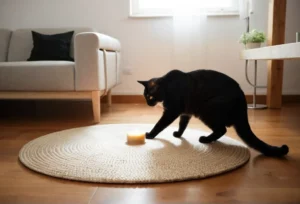Cats have a mysterious way of captivating our hearts with their independent nature and adorable antics. One curious behavior many cat owners may notice is their affinity for baby talk. Have you ever wondered why cats seem to respond so positively to this form of communication? Let’s explore the reasons behind this feline fascination with baby talk.
The Unique Bond Between Cats and Humans
Cats have a long history of evolution as domesticated animals, dating back thousands of years. Unlike their wild ancestors, domestic cats have developed a unique relationship with humans. This close bond has influenced how they communicate with us, including their preference for baby talk.
Cats have learned to interpret and respond to human vocal cues, much like how they would communicate with their own kittens. When we use high-pitched, sing-songy voices and simplified phrases similar to baby talk, it triggers a positive response in cats. They associate this tone with affection, attention, and care, strengthening the bond between feline and human companions.
This evolution in cat communication highlights the deep connection between cats and humans, showing how they have adapted to understand and appreciate our language, including the gentle, nurturing tones of baby talk.
The Similarities Between Baby Talk and Cat Communication
When it comes to communication, both baby talk and cat language share fascinating similarities that enhance the mutual appeal between cats and humans. Just like infants, cats respond well to soothing, melodic sounds and repetitive phrases. Baby talk often involves simple, exaggerated words and expressions, which cats also find engaging and comforting.
In addition, the use of body language plays a crucial role in both baby talk and cat communication. Cats rely heavily on facial expressions, posture, and gestures to convey their feelings and needs, a trait that resonates with the non-verbal cues present in baby talk. By mirroring this form of communication, we create a sense of familiarity and understanding for our feline friends.
Furthermore, the use of affectionate terms in baby talk, such as “sweetie” or “cutie,” mirrors the loving nicknames many cat owners give their pets. This shared language of endearment reinforces the emotional connection between cats and humans, making baby talk a comforting and effective way to communicate with our beloved feline companions.
Additional Insight: A unique aspect of cat communication is their ability to purr. Purring is not only a sign of contentment but also serves as a form of communication, often used to express comfort, relaxation, or even healing. This gentle sound reinforces the bond between cats and humans, creating a sense of peace and well-being for both parties.
The Comforting Effect of Baby Talk on Cats
Have you ever noticed how your cat seems to relax when you speak to them in a soft, high-pitched tone? Well, that’s because baby talk has a comforting effect on our feline friends. The gentle tone and rhythm of baby talk mimic the soothing sounds kittens hear from their mothers, triggering a sense of security and safety in cats. So next time you cuddle up with your furry companion, don’t hesitate to use that sweet baby voice—it might just help them feel even more at ease in your presence.
Instinctual Reactions to High-Pitched Sounds
Cats have a keen sensitivity to high-pitched sounds, which is thought to stem from their hunter instincts. In the wild, small prey animals often emit high-pitched squeaks or cries when in distress, alerting predators like cats to their presence. So when you engage in baby talk with your cat, they may instinctively respond positively to the higher pitch, associating it with harmless, non-threatening communication. This natural reaction can help strengthen the bond between you and your feline companion, making them feel more connected and understood.
Why do Cats Like Baby Talk?
- Mimics Motherly Sounds: Baby talk replicates the comforting sounds kittens hear from their mother, creating a sense of security.
- Instinctual Response: Cats’ sensitivity to high-pitched sounds can trigger a positive reaction to baby talk, based on their hunting instincts.
- Bond Strengthening: Using baby talk with your cat can help foster a deeper connection and understanding between you both.
- Calming Effect: The gentle tone and rhythm of baby talk have a calming and reassuring effect on cats, promoting relaxation and comfort.
- Communication Tool: Baby talk can serve as a form of gentle communication that cats find engaging and comforting.
Remember, when it comes to communicating with your cat, a little baby talk can go a long way in creating a harmonious and loving relationship. So go ahead, speak to your furry friend in that sweet, soothing tone—they’ll thank you with purrs and cuddles.
The Role of Body Language in Cat Communication
Cats are highly attuned to body language, using it as a primary means of communication. When interacting with your feline friend, consider combining baby talk with soothing body language to strengthen your bond. By matching your gentle words with calming gestures like slow blinks, soft petting, and slow movements, you create a harmonious connection that cats find comforting. This synchronization of verbal and non-verbal cues can promote feelings of security and trust in your cat, fostering a deeper sense of companionship.
Key Tip: When engaging in baby talk with your cat, be mindful of your body language. Use slow, deliberate movements and gentle touches to convey your affection and care, enhancing the overall communication experience.
The Importance of Positive Reinforcement
Utilizing baby talk as a form of positive reinforcement can be highly beneficial in both training and bonding with your cat. Cats respond positively to nurturing tones and encouraging words, associating them with rewards and affection. By consistently pairing baby talk with treats, playtime, or other forms of positive reinforcement, you reinforce desirable behaviors and strengthen the bond between you and your furry companion. This approach not only enhances training outcomes but also fosters a loving and supportive relationship based on trust and mutual respect.
Key Tip: Incorporate baby talk into your training sessions to create a positive and engaging learning environment for your cat. By using a warm and encouraging tone, you can motivate and reward your cat effectively, helping them thrive and flourish in their training endeavors.
For additional insights on cat behavior and communication, you can refer to reputable sources such as the American Society for the Prevention of Cruelty to Animals (ASPCA). Their comprehensive guides offer valuable information on understanding and interacting with feline companions.
Interesting Facts About Cat Communication
Cats are highly communicative animals, and they have a variety of ways to express themselves. From body language to vocalizations, they use different cues to convey their feelings and needs. One interesting fact is that cats can make over 100 different sounds, while dogs only make about ten.
When it comes to baby talk, cats are known to respond positively to high-pitched, melodic sounds. This is because baby talk mimics the frequency and intonation of a mother cat when she communicates with her kittens. So, when you use baby talk with your cat, they may interpret it as soothing and comforting, strengthening your bond with them.
Another intriguing fact is that cats’ whiskers are highly sensitive and play a crucial role in communication. Whiskers can detect changes in the environment, allowing cats to navigate their surroundings and communicate non-verbally with other animals. So, when your cat rubs their whiskers against you, they’re not only showing affection but also communicating their trust and comfort in your presence.
In addition to baby talk, using slow blinks with your cat can also enhance your communication. Slow blinks are a sign of relaxation and trust in the feline world. By reciprocating your cat’s slow blinks, you can create a positive and peaceful connection with them, further strengthening your bond.
Remember, understanding cat communication cues and using techniques like baby talk and slow blinks can help you build a strong and harmonious relationship with your feline friend.
Additional Unique Insight:
Did you know that cats have scent glands on their cheeks and chin? When they rub their face against you, they are not only marking you as part of their territory but also showing affection and trust. So, next time your cat gives you a gentle head bump, feel honored – they are communicating their love for you in their own unique way.
Alex, a passionate animal lover, has experience in training and understanding animal behavior. As a proud pet parent to two dogs and three cats, he founded AnimalReport.net to share insights from animal experts and expand his knowledge of the animal kingdom.




